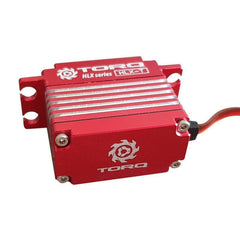Join Our newsletter
Subcribe to get information about products and coupons





Couldn't load pickup availability
- Using the newest Hall Sensor Technology
- Blistering 0.035 Second Transit Speed
- Dedicated Helicopter Rudder Servo
- Incredible Levels of Speed & Performance
- Ultra Precise, High Resolution Control
- Newly Design Steel Gear Train for Maximum Strength
- Excellent Thermal Dissipation via Finned 6061 Aluminum Case
- 8.4V High Voltage Ready
- Optimized for High Demand Rudder Control
- 6 Ball Bearings Construction
Speed:
0.03 sec / 60° @ 8,2V
0.035 sec / 60° @ 7.4V
0.04 sec / 60° @ 6.0V
Torque:
13.0Kg.cm / 180,53 oz. in. @ 8.2V
11.0Kg.cm / 152,76 oz. in. @ 7.4V
9.0Kg.cm / 124,98 oz. in. @ 6.0V
Specifications:
Motor Type: Brushless
Servo Arm Type: Futaba
Working Pulse Width / Frequency: 760us / 560Hz 450us-1050us
Weight: 80g
Dimensions: 40mm x 20mm x 40mm (LxWxH)
Voltage Range: 6.0V - 8.4V
Usage Note:

| Vendor: | TORQ Servos |
| SKU: | HLX-T |
| Barcode: | 0769923264882 |
| Availability: | In Stock |
| Product Type: | Heli Servo |
| Weight: | 0.3 lb |
I have used these in several customers Helis black and red and haven't had any complaints. These are great servos
HeliDirect excellent and quality goods supply Quick worldwide delivery.
Love the fact that its Hall Effect. Time will tell how much longer it lasts over potentiometer based servos. But its a solid performer for the money.
Extremely precise tail servo and very well made.
I have several helicopters using Torq servos. This one is sitting in a new SAB Raw 580. This is the first HLX series. I’m totally impressed with its performance. The servo box makes setup a breeze. I did use the Torq mini servos on the collective, in retrospect I think using the HLX series might be a good choice there as well but the mini’s are a great servo too. You have many choices of servos. Based on my experience, this is a good one to look at.
Excellent product, very good quality and very beautiful, meets all my expectations.
Bought this for my SAB gasser conversion. Works great!
Very nice servo
Bought for SAB 700 Piuma helicopter, look top quality.
Thanks for subscribing!
This email has been registered!